#Black garlic fermentation
Explore tagged Tumblr posts
Text
Black Garlic North America is a business division of Wisconsin Fermentation Company LLC (founded in 2012). Wisconsin Fermentation Company is focused on fermentation innovation as well as product and manufacturing design and commercialization. The combination of chemistry, microbiology, mycology, engineering, and food technology pave the way for technical expertise within a wide array of fermented products. Currently our flagship product is Black Garlic marketed under the brand name Black Garlic North America.
#Black garlic fermentation#black garlic#Black garlic retailer#fermented black garlic manufacturers#garlic cracker recipe#garlic guacamole recipe
0 notes
Text

Vegan Singapore Black Pepper Sauce Spaghetti
#vegan#lunch#dinner#singaporean cuisine#southeast asian cuisine#pasta#spaghetti#cauliflower#black pepper#shallots#garlic#cornstarch#chili#curry leaves#fermented bean paste#vegan oyster sauce#soy sauce#coconut sugar#white pepper
48 notes
·
View notes
Text
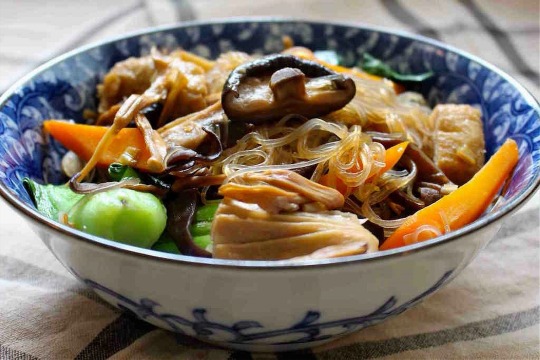
Lo hand Chai Buddha's Delight
Lo han chai, aka Buddha's delight, is a spicy braised vegetable dish that's enjoyed by many families on the first day of the Chinese New Year. Lo Han’ is the Chinese name for the eighteen Arhats in Buddhism, which are the saints equivalent to the apostles of Christianity. Lo Han Jai means the vegetarian dish eaten by the saints.
For this recipe, please go to:
For hundreds of delicious recipes and mouthwatering food images, please go to:
#dried shiitake mushrooms#dried lily flowers#wood ear fungus#black moss#cellophane noodles#garlic#ginger#scallions#napa cabbage#pak choi#carrots#Shaoxing rice wine#soy sauces#red fermented ben curd#fried tofu puffs#sesame oil
0 notes
Text
Gut Friendly Grocery List 🥦🥑🧀
🧀 Probiotic and Fermented Foods:
Yogurt (look for live and active cultures)
Kefir
Sauerkraut
Kimchi
Pickles (fermented)
Tempeh
Miso
Fermented cheeses (e.g., cheddar, gouda, Swiss)
Kombucha
🫘 Fiber-Rich Foods:
Whole grain bread, cereal or pasta
Oats
Brown rice
Quinoa
Lentils
Chickpeas
Black beans
🍳 Protein:
Lean meats (chicken, turkey, lean cuts of beef or pork)
Fish (salmon, mackerel, sardines)
Eggs (rich in amino acids)
Tofu and tempeh (fermented soy products)
Cottage cheese
🍎 Fruits:
Berries (blueberries, strawberries, raspberries)
Bananas
Apples
Oranges
Lemons
Watermelon
🥦 Vegetables:
Spinach
Broccoli
Cauliflower
Brussels sprouts
Asparagus
Onions
Garlic
Artichokes
Sweet Potato
Jicama
Chicory root
Dandelion greens
🥜 Nuts and Seeds:
Almonds
Walnuts
Flaxseeds
Chia seeds
Pumkin seeds
🥑 Healthy Fats:
Avocado
Olive oil
Grass fed butter
🍠 Herbs and Spices:
Turmeric
Ginger
Garlic
🧉 Beverages:
Green tea
Herbal teas
Aloe vera juice
Coconut water
🍫 Other:
Dark chocolate (in moderation)
Apple cider vinegar
Bone Broth
Raw honey
sea salt
Collagen
Seaweed
#gut health#healthy diet#healthy living#health and wellness#health#wellness#healthy lifestyle#health is wealth#groceries#nutrition
3K notes
·
View notes
Text
some descriptions under the cut :)
WINTERCAKE: "The taste of wintercake filled his mouth again, rich with ginger and pine nuts and bits of cherry, with nahsa to wash it down, fermented goat's milk served in an iron cup and laced with honey."
SISTER'S STEW: "The beer was brown, the bread black, the stew a creamy white. She served it in a trencher hollowed out of a stale loaf. It was thick with leeks, carrots, barley, and turnips white and yellow, along with clams and chunks of cod and crabmeat, swimming in a stock of heavy cream and butter. It was the sort of stew that warmed a man right down to his bones, just the thing for a wet, cold night. Davos spooned it up gratefully."
SNAILS: "Snails in honey and garlic. Sansa had never eaten snails before; Joffrey showed her how to get the snail out of the shell, and fed her the first sweet morsel himself."
BOWL OF BROWN: "...So thick you could stand your spoon up in the bowl, with chunks of this and that."
#asoiaf#polls#maybe the abundant food descriptions are for ME to salivate over#not sure on how kosher or halal this food is. the boar definitely isnt
144 notes
·
View notes
Text

[ID: A close-up of a baguette lined with sliced cucumber and topped with cauliflower coated in a deep red sauce, diced tomato, and a white sauce. End ID]
Sandwich with sesame-gochujang cauliflower and garlic-yoghurt sauce
Inspired by Vietnamese bánh mì thịt, this submarine sandwich pairs fresh vegetables with fried cauliflower coated in a spicy, tangy, savory, and sweet sauce. Toasted sesame oil and the fermented notes of gochujang add depth and complexity to the mildly nutty backdrop of the cauliflower, while the raw garlic in the yoghurt sauce brings the taste profile to a sharp head.
Also consider pairing the gochujang cauliflower with vegetables of your choice in a rice bowl or salad.
Recipe under the cut!
Patreon | Paypal | Venmo
Ingredients:
Serves 4.
For the dish:
4 bánh mì, or 2 freshly baked baguettes halved and cut open
300g cauliflower florets (1/2 a small head)
1/2 cucumber, sliced
2 inches carrot, julienned
1 small roma tomato, diced
Other toppings of choice
Drizzle toasted sesame oil
1 Tbsp toasted sesame seeds
For the batter:
2 Tbsp (15g) all-purpose flour
2 Tbsp (20g) potato starch
1 Tbsp (10g) egg replacer for baking (optional)
Water
For the gochujang sauce:
2 Tbsp gochujang
1 Tbsp gochugaru (Korean red chili flakes)
1 Tbsp granulated sugar
1 Tbsp Korean soy sauce
2 tsp rice vinegar
2 cloves garlic, grated
1 green onion, sliced
Pinch salt
Pinch MSG (optional)
Several cracks ground black pepper
Water
For the yoghurt sauce:
1/4 cup non-dairy yoghurt
1 clove garlic, grated
1 tsp high-fructose corn syrup, or sugar
1/2 tsp rice vinegar
Pinch salt
Instructions:
1. Break cauliflower into smallish florets and wash. Prep vegetables.
2. Mix all gochujang sauce ingredients and use a blender or immersion blender to pulverise the green onion. Add a bit of water as necessary to achieve a slightly runny consistency. Set aside.
3. Mix all yoghurt sauce ingredients and whisk to combine. Set aside.
4. Heat a small pot with several inches of oil to 350 °F (175 °C). Mix all dry batter ingredients in a mixing bowl. Add just enough water to obtain a mixture the consistency of pancake batter. Do not overmix.
5. Coat cauliflower with batter and carefully drop one floret at a time into the oil. You may have to fry them in multiple batches. Fry until lightly golden brown and floating. Set aside onto a paper-towel-lined plate.
6. Increase the heat to bring the oil to 400 °F (200 °C). Fry cauliflower again for 30 seconds until deeply golden brown. Set aside.
If you aren't comfortable deep-frying, you may bake battered cauliflower at 400 °F (200 °C) for 30 minutes, turning over halfway through.
7. Heat a large skillet on medium and cook gochujang sauce, stirring often, until thickened. Add cauliflower and stir to coat. Drizzle in sesame oil and sesame seeds and stir again.
8. Serve immediately with bread, vegetables, and yoghurt sauce.
114 notes
·
View notes
Text
HONEYS GUIDE TO NUTRITION* ˗ˏˋ༻
this is going to serve as general information about nutrition so that u guys can build good diets and healthy eating habits <3
FIBER-RICH FOODS : apples, avocados, raspberries, carrots, broccoli, quinoa, bananas, oats, lentils, black beans, almonds, strawberries, chickpeas, popcorn, brussel sprouts, blueberries
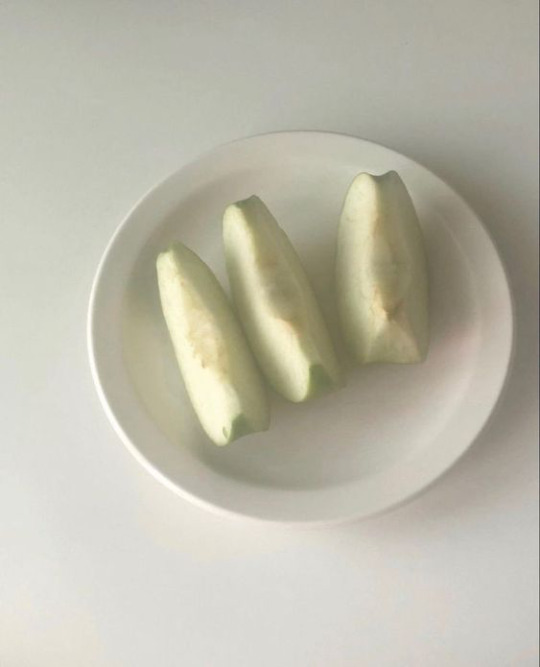
PROTEIN-RICH FOODS : tuna, chicken, peanut butter, beans, eggs, turkey, edamame beans, pistachios, cheese, milk, quinoa, beef, pork, salmon, chickpeas, almonds, seeds, yogurt, tofu, peas
GENERAL NUTRTIONAL INFORMATION : carbs = energized, protein = satisfaction, fiber = full, fats = stable energy levels, cravings = happiness (make sure to get a balance of all five 💗)
HEALTHY GUT : eating fermented foods increases the good bacteria in ur gut. kimchi, sauerkraut, kefir, miso, garlic, asparagus, leeks, bananas and avocado.
ALL ABOUT TEA : numerous studies have shown that drinking a variety of teas boosts ur immune system, and fights off inflammation.
SUPPLEMENTS AND VITAMINS : omega threes promote heart health, brain function, and reduces inflammation. vitamin D increases the absorption of calcium and magnesium which supports immune function and bone health (most commonly obtained with sunlight) zinc is good for wound healing, collagen is good for hair skin and nails, vitamin E is a powerful antioxidant that helps repair cellular damage
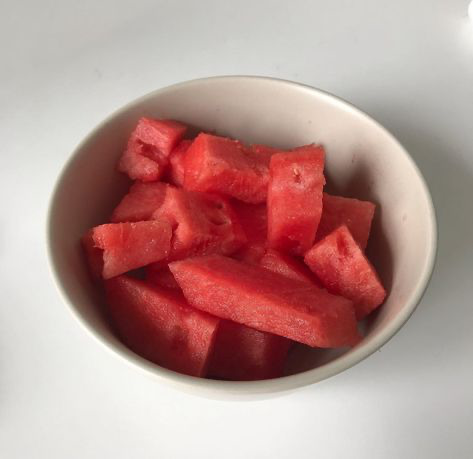
#self care#it girl#becoming that girl#that girl#it girl energy#dream girl#nutrition#lifestyle#healthy#healthy lifestyle
145 notes
·
View notes
Text
Cheese is a food derived from milk that is produced in a wide range of flavors, textures, and forms by coagulation of the milk protein casein. It comprises proteins and fat from milk, usually the milk of cows, buffalo, goats, or sheep. During production, the milk is usually acidified, and adding the enzyme rennet causes coagulation. The solids are separated and pressed into final form. Some cheeses have molds on the rind or throughout. Most cheeses melt at cooking temperature.
Hundreds of types of cheese from various countries are produced. Their styles, textures and flavors depend on the origin of the milk (including the animal's diet), whether they have been pasteurized, the butterfat content, the bacteria and mold, the processing, and aging. Herbs, spices, or wood smoke may be used as flavoring agents. The yellow to red color of many cheeses, such as Red Leicester, is produced by adding annatto. Other ingredients may be added to some cheeses, such as black pepper, garlic, chives or cranberries.
For a few cheeses, the milk is curdled by adding acids such as vinegar or lemon juice. Most cheeses are acidified to a lesser degree by bacteria, which turn milk sugars into lactic acid, then the addition of rennet completes the curdling. Vegetarian alternatives to rennet are available; most are produced by fermentation of the fungus Mucor miehei, but others have been extracted from various species of the Cynara thistle family. Cheesemakers near a dairy region may benefit from fresher, lower-priced milk, and lower shipping costs.
Cheese is valued for its portability, long life, and high content of fat, protein, calcium, and phosphorus. Cheese is more compact and has a longer shelf life than milk, although how long a cheese will keep depends on the type of cheese; labels on packets of cheese often claim that a cheese should be consumed within three to five days of opening. Generally speaking, hard cheeses, such as parmesan last longer than soft cheeses, such as Brie or goat's milk cheese. The long storage life of some cheeses, especially when encased in a protective rind, allows selling when markets are favorable.
There is some debate as to the best way to store cheese, but some experts[who?] say that wrapping it in cheese paper provides optimal results. Cheese paper is coated in a porous plastic on the inside, and the outside has a layer of wax. This specific combination of plastic on the inside and wax on the outside protects the cheese by allowing condensation on the cheese to be wicked away while preventing moisture from within the cheese escaping.
A specialist seller of cheese is sometimes known as a cheesemonger. Becoming an expert in this field requires some formal education and years of tasting and hands-on experience, much like becoming an expert in wine or cuisine. The cheesemonger is responsible for all aspects of the cheese inventory: selecting the cheese menu, purchasing, receiving, storage, and ripening.
14 notes
·
View notes
Note
HEY I SAW UR POST ‼️‼️
Can I know more abt ur hcs on Nodth African James? Its cool asf and I'm interested to know more 💚🍀🎀
HII IM GLAD YOU LIKED ITTT
Soo on my NA!James this is focused on Marocan/Algerian
I feel that his Arabic name would be either "Jasir(ja-sir n it means courageous/bold it's too on the nose tbh but it's pretty)" or "Jad and it means and bear w me on this serious hehehe"
Soo I don't think he's gonna like Kouskus like at all ,it feels like sand in his mouth and it doesn't fill him up and the vegetables get mixed up and he hates chickpeas and and- he can come up with a thousand reasons why he doesn't like it
by Effie makes it every Friday "it's tradition to do so James! deal with it" Soo boy eats noodles every Friday 😭 he'd pout about it
Sirius l o v e s Kouskus and doesn't get why James is so picky and eats it every Friday without fail- even gets second servings Effie is always telling James "look Sirius like it, you're just dramatic"
speaking of food, Sirius was used to your typical croissant and coffee french breakfast,so seeing a whole ass feast for breakfast was a jarring experience
I'm talking boiled eggs , coffee,milk, flatbread,homemade fresh and warm bread (Effie is an early bird and she bakes almost every morning) leben (fermented milk), garlic,olives , olive oil
like Monty eats raw garlic in the morning, Sirius is shocked,but then again that man has the power of horse,maybe that's why
also their coffee is strong and Effie drinks that shit black
James knows Arabic, french and English and some berber,so yeah, Sirius/regulus talking french ain't shit,he can n will keep up
he would listen to ray so muchh I hate him
he owns a djellaba and a burnous, Effie makes him wear them in Yannaer (berber's new year)
Effie does henna to both Sirius and James,but not full palm n fingers maybe just a bit in their pinkies
Effie is amazigh (berber) while Monty would probably be from Shlef or something
he would use the sound "aaaahhh" to express multiple emotions , it's like it's own language
Soo yeah, I don't have much bc I thought of him this morning but I'm sure I'll have more after he marinates in my head
#harry potter#the maruaders#maraudes#dead gay wizards#dead gay wizards from the 70s#gay dead wizards#marauders era#mauraders#the marauders#the marauders era#hp marauders#harry potter marauders#marauder era#james potter#james fleamont potter
25 notes
·
View notes
Text


Stir-Fried Lotus Root with Garlic and Black Bean 豆豉炒藕片 (Vegan)
#vegan#appetizer#chinese cuisine#east asian cuisine#stir fry#lotus root#garlic#fermented black beans#dou chi#doubanjiang#chili#bell peppers#sesame oil#coconut sugar#sea salt
27 notes
·
View notes
Text
🩷First day ABC mid restriction diet 🩷800 cal 🩷
Breakfast :
black coffee -0 cal
Fruit consisting of 1 kiwi 45 cal
17 green grapes 59 cal
Cantaloupe 1 ounce 10 cal
2 boiled eggs 156 cal
Total 270 cal 🤍🩷
Had my green tea 🍵 and honey garlic for an immune boost (forgot to add that 1 garlic clover fermented in raw honey about 1 tsp)
And had my small glass of salt water
🍂🤍🧸🤎🐰🍂🐻🤎☕️🤍🍂
#eating disoder trigger warning#ana rexx#light as a feather#tw ana rant#ed but not ed sheeran#tw ed ana#tw ana bløg#analog#healthyliving#anaisperfect#low cal restriction#tw restriction#ana inspiration#life with ana#anasp0#need a ana buddy
9 notes
·
View notes
Text
Samhain Masterpost - Spoonie Witch Friendly

Samhain, Halloween as we know it. Celebrated on October 31st to November 1st (May 1st in the Southern Hemisphere). Samhain is a cross-quarter fire celebration and the halfway point between the Autumn Equinox and the Winter Solstice.
Samhain is the 3rd and final fall harvest festival. This day is also known as the Witches New Year.
The veils are believed to be thinned, allowing the dead to return to the earth. Samhain is celebrated in many different cultures around the world. An important holiday to most.
Correspondences
Colours
Black
Deep Purple
Silver
Grey
Orange
Gold
Dark Red
Herbal
Sage
Mugwort
Rosemary
Garlic
Hemlock
Belladonna
Marigold
Red Roses
Cedar
Cinnamon
Edibles
Apples
Pumpkin
Spiced Cake
Gourds
Squash
Mulled Wine
Corn
Mead
Nuts
Cider
Seeds
Fermented Food
Animals
Cats
Spiders
Moths
Wolves
Owls
Crows
Ravens
Scorpian
Bats
Vultures
Rats
Swans
Crystals
Moonstone
Amethyst
Carnelian
Obsidian
Black Tourmaline
Bloodstone
Silver
Iron
Onyx
Spiritual meanings & intentions
Transformation
New Journeys
Ancestors
Heritage
Death
Sorrow
Loss
Afterlife
Rebirth
Knowledge
Insight
Foresight
Relaxation
Recuperation
Divination
Planning and preservation
Shadow Work
Thinning of the Veil
Fae
Scents
Cinnamon
Nutmeg
Cloves
Honey
Pine
Star Anise
Sage
Pumpkin
Gods / Goddesses / Spirits
The Morrigan (Irish)
Hekate (Greek)
Demeter (Greek)
Hel (Norse)
Freyja (Norse)
Persepone (Greek)
Cerridwen (Celtic)
Rhiannon (Celtic)
Psyche (Greek)
Osiris (Egyptian)
Anubis (Egyptian)
Hades (Greek)
Cernunnos (Celtic)
Loki (Norse)
Dionysis (Greek)
Need some suggestions to celebrate? I got you covered.
High energy celebrations
Cleanse
Do a release ritual
Divination
Connect with ancestors
Carve a jack o’ lantern
Make a besom
Create witches bottle
Visit a graveyard and give your respects (be respectful!)
Low energy celebrations
Leave offering for ancestors
Chat with the folk about family history
Light incense
Burn something you’d like to let go on a piece of paper
No spoon celebrations
Eat pumpkin or any sort of squash
Leaving some of your food aside for the ancestors
Any sort of mischief. Telling a joke or pulling a prank
Remember that it’s okay if you cant do much while you are unwell. That you come first and you simply existing is a blessing.
How you celebrate the holiday does not matter. You can choose to do any activity that feels right. These are only suggestions and remember that you're enough no matter what.
#samhain offerings#samhain association#samhain#wheel of the year#samhain correspondances#spoonie magic#spoonie witch#spoonie withcraft
106 notes
·
View notes
Text
Foods You Can Eat Instead of Taking Vitamins and Supplements 🍎🥥🥦🥑🍌
Vitamin A: Carrots, sweet potatoes, spinach, kale.
B Vitamins: Whole grains, meat, eggs, nuts, legumes.
Vitamin B1 (Thiamine): Whole grains, legumes, nuts, pork, fortified cereals.
Vitamin B2 (Riboflavin): Dairy products, lean meats, almonds, leafy greens. Vitamin B3 (Niacin): Poultry, fish, nuts, legumes, whole grains.
Vitamin B5 (Pantothenic Acid): Meat, poultry, eggs, avocado, whole grains.
B6: Chicken, turkey, fish, bananas, chickpeas.
Folate (Vitamin B9): Leafy greens, legumes, citrus fruits, fortified grains.
Vitamin B12: Animal products (meat, fish, dairy), fortified plant-based foods.
Vitamin C: Citrus fruits, strawberries, bell peppers.
Vitamin D: Fatty fish (salmon, mackerel), fortified dairy products, sunlight.
Vitamin E: Sunflower seeds, almonds, vegetable oils, nuts, spinach, broccoli.
Vitamin F (Essential Fatty Acids): Fatty fish, flaxseeds, chia seeds, walnuts.
Vitamin H (Biotin): Eggs, nuts, sweet potatoes, salmon, avocado.
Vitamin K: Leafy greens (kale, spinach), broccoli, Brussels sprouts.
Vitamin K2: Fermented foods (natto, cheese), animal products, leafy greens.
Vitamin L1 (Anthranilic Acid): Cruciferous vegetables (cabbage, cauliflower), legumes.
Vitamin P (Bioflavonoids): Citrus fruits, berries, onions, green tea.
Vitamin Q (Ubiquinone): Fatty fish, organ meats, spinach, cauliflower.
Vitamin T (L-carnitine): Red meat, poultry, fish, dairy products.
Vitamin U (S-Methylmethionine): Cabbage, broccoli, Brussels sprouts.
Betaine: Beets, spinach, whole grains, seafood.
Boron: Fruits (apples, pears), legumes, nuts, avocado.
Calcium: Dairy products, leafy greens (kale, collard greens), almonds.
Carnosine: Beef, poultry, fish.
Carnitine: Red meat, dairy products, fish.
Catechins: Green tea, black tea, dark chocolate.
Choline: Eggs, liver, beef, broccoli, soybeans.
Creatine: Red meat, fish, poultry.
Chromium: Broccoli, whole grains, nuts, brewer's yeast.
Chondroitin: Cartilage-rich foods (bone broth, connective tissue of meat).
Copper: Shellfish, nuts, seeds, organ meats, lentils.
Coenzyme Q10 (CoQ10): Fatty fish, organ meats, nuts, soybean oil.
Ellagic Acid: Berries (strawberries, raspberries), pomegranates.
Glucosinolates: Cruciferous vegetables (cabbage, broccoli, cauliflower).
Glucosamine: Shellfish (shrimp, crab), bone broth, animal connective tissues.
Glutamine: Dairy products, meat, poultry, cabbage.
Inositol: Citrus fruits, beans, nuts, whole grains.
Iodine: Seafood, iodized salt, dairy products.
Iron: Red meat, poultry, beans, lentils, spinach.
L-Theanine: Mushrooms, black tea, white tea, guayusa.
Lignans: Flaxseeds, whole grains, cruciferous vegetables.
Lutein and Zeaxanthin: Leafy greens (spinach, kale), corn, eggs.
Lycopene: Tomatoes, watermelon, pink grapefruit.
Magnesium: Spinach, nuts, seeds, whole grains, beans.
Manganese: Nuts, seeds, whole grains, leafy greens, tea.
Melatonin: Cherries, grapes, tomatoes.
Omega-3 fatty acids: Flaxseeds, chia seeds, walnuts, fatty fish.
PABA (Para-Aminobenzoic Acid): Whole grains, eggs, organ meats.
Pantothenic Acid (Vitamin B5): Meat, poultry, fish, whole grains, avocado
Pectin: Apples, citrus fruits, berries, pears.
Phosphorus: Dairy products, meat, poultry, fish, nuts.
Prebiotics: Garlic, onions, leeks, asparagus, bananas (unripe), oats, apples, barley, flaxseeds, seaweed.
Probiotics: Yogurt, kefir, fermented foods (sauerkraut, kimchi).
Potassium: Bananas, oranges, potatoes, spinach, yogurt.
Polyphenols: Berries, dark chocolate, red wine, tea.
Quercetin: Apples, onions, berries, citrus fruits.
Resveratrol: Red grapes, red wine, berries, peanuts.
Rutin: Buckwheat, citrus fruits, figs, apples.
Selenium: Brazil nuts, seafood, poultry, eggs.
Silica: Whole grains, oats, brown rice, leafy greens.
Sulforaphane: Cruciferous vegetables (broccoli, Brussels sprouts), cabbage.
Taurine: Meat, seafood, dairy products.
Theanine: Green tea, black tea, certain mushrooms.
Tyrosine: Meat, fish, dairy products, nuts, seeds.
Vanadium: Mushrooms, shellfish, dill, parsley, black pepper.
Zeatin: Whole grains, legumes, nuts, seeds.
Zinc: Oysters, beef, poultry, beans, nuts, whole grains.
#women health#health and wellness#healthy diet#healthy living#healthy lifestyle#womens health#health#health tips#wellness#levelupjourney#dream girl guide#dream girl tips#dream girl journey#health is wealth#clean girl aesthetic#clean girl#it girl#nutrition#supplements#organic#food#nutrients#healthyhabits#healthy life tips#self love journey#self love#dream life#dream girl
2K notes
·
View notes
Note
A sandwich.
It contains ice cream, whipped cream, sponge cake, meat balls, broccoli, pineapple, strawberries, tomatoes, lettuce, rice, noodles, mac and cheese, bacon, beef jerky, dried fish, seaweed, one of every Pokemon berry, jam, olive oil, lotus, dragon fruit, ravioli, ramen, tempura, teriyaki chicken, macaroons, escargots, mint, pepper, salt, sugar, croquettes, pickles, apples, avocados, sausages, bell peppers, grapes, pizza, a donut, cheese, more cheese, even more cheese, mushrooms, mustard, olives, a fried egg, a scrambled egg, blueberries, a poached egg, chawanmushi, a red bean bun, mochi, bbq sauce, chicken nuggets, french fries, takoyaki, pancakes, mackerel, salmon, coffee beans, spinach, a tiny bit of corn cream soup, ramensanga, fettucine alfredo, a plain bagel, pretzels, chocolate chip cookies, sweet potato, yam, potato, scallions, scallops, squid, crab stick, fish balls, fish cakes, oyster sauce, silken tofu, barley, cereal, paprika, oysters, red snapper, sea bass, plums, bean sprouts, garlic, string cheese, camembert, swiss cheese, mozzarella, parmesan cheese, yogurt, brinjal, a macdonald’s happy meal (without the toy and the packaging of course), truffles, caviar, tapioca balls, fried chicken, century eggs, cake sprinkles, dark chocolate, milk chocolate, white chocolate, milk tea (just a tinge), coffee (also a tinge), pudding, pumpkin, honey, mutton, mashed potatoes, bananas, icelandic fermented shark that they bury in the ground for months, raisins, dried mangoes, a drop of water, jelly, nata de coco, prunes, roasted pork, rosemary, bee pollen, peas, deer meat, rabbit meat, fish maw, ham, turkey, m&ms, chub, fufu, watermelon, winter melon, rock melon, coffee jelly, cacao, carrots, blueberries, black tea, dumplings, carrot cake, beetroot, purple cabbage, corn, celery, edamame, red beans, black beans, green beans, kidney beans, cashews, peanuts, pecans, sunflower seeds, walnuts, chickpeas, almonds, daikon, MSG, tamales, anchovies, tabbouleh, lions mane mushroom, chicken of the woods, kelp, octopus, durian, kimchi, crème fraîche, popcorn, cotton candy, everything bagel seasoning, capers, pears, marinara sauce, bittercress, butter cream, every single iteration of galarian curry, sushi, sashimi, kale and a very very specific ramen bowl (without the actual bowl) from a very particular shop located in Iwatodai.
And the top and bottom buns are somehow made from 50 different kinds of bread in a checker box pattern.
It comes with a picture.
Ingredients: I am not typing all of that out again. What the fuck.
Smell: You’ve taken an entire food court’s worth of food and made it into a sandwich. This isn’t even possible. Why am I considering this. 3/5
Taste: How do you eat this. 2/5
Texture: You get like 5 different foods every bite. This is not balanced. There is no harmony. This sandwich is the embodiment of disorder and chaos. 1/5
Presentation: The fact that this even looks sandwich adjacent is a fucking miracle. You don’t get full points though. Because I don’t like you. 3/5
Would Chunk Eat It?: He would eat maybe 1/50th of it. So no. 1/5
Final Score: 2/5
Critic’s Notes: Why would you waste this much food. Just host a party. Donate it. Something fucking anything I am begging at this point.
24 notes
·
View notes
Text
╰₊🧂 𝘚𝘦𝘢𝘴𝘰𝘯𝘪𝘯𝘨 𝘝𝘰𝘤𝘢𝘣𝘶𝘭𝘢𝘳𝘺 𝜗𝜚

Bay leaf ~ 香叶 (xiāng yè) BBQ seasoning ~ 烧烤调料 (shāokǎo tiáoliào) Basil ~ 罗勒 (luólè) Black vinegar ~ 黑醋 (hēi cù) Cane sugar ~ 甘蔗糖 (gānzhè táng) Caper ~ 开普 (kāipǔ) Cayenne pepper ~ 辣椒粉 (làjiāo fěn) Chives ~ 韭菜 (jiǔcài) Cilantro ~ 香菜 (xiāngcài) Clove ~ 丁香 (dīngxiāng) Coleslaw ~ 美式卷心菜沙拉 (měishì juǎn xīncài shālā) Cooking wine ~ 料酒 (liàojiǔ) Cumin ~ 孜然 (zīrán) Dark soy sauce ~ ���抽 (lǎo chōu) Dill ~ 莳萝 (shíluó) Fennel ~ 茴香 (huíxiāng) Fermented bean curd ~ 豆腐乳 (dòufu rǔ) Garlic ~ 大蒜 (dàsuàn) Gravy ~ 肉汁 (ròuzhī) Hoisin sauce ~ 海鲜酱 (hǎixiān jiàng) Hummus ~ 鹰嘴豆泥 (yīngzuǐ dòuní) Jalapeño ~ 墨西哥辣椒 (mòxīgē làjiāo) Ketchup ~ 番茄酱 (fānqié jiàng) Lavender ~ 薰衣草 (xūnyīcǎo) Lemongrass ~ 柠檬草 (níngméngcǎo) Light soy sauce ~ 生抽 (shēng chōu) Maple syrup ~ 枫糖浆 (fēng tángjiāng) Mayo ~ 蛋黄酱 (dànhuáng jiàng) Mint ~ 薄荷 (bòhé) Miso ~ 味噌 (wèizēng) Mugwort ~ 艾草 (àicǎo) Mustard ~ 芥末 (jièmò) Nutmeg ~ 肉豆蔻 (ròudòukòu) Oregano ~ 牛至 (niúzhì) Oyster sauce ~ 蚝油 (háoyóu) Paprika ~ 辣椒粉 (làjiāo fěn) Parsley ~ 欧芹 (ōuqín) Pepper ~ 胡椒 (hújiāo) Peppermint ~ 薄荷 (bòhé) Poppy seed ~ 罂粟籽 (yīngsù zǐ) Ranch dressing ~ 牧场沙拉酱 (mùchǎng shālā jiàng) Red pepper flakes ~ 红辣椒片 (hóng làjiāo piàn) Rosemary ~ 迷迭香 (mídiéxiāng) Saffron ~ 番红花 (fānhónghuā) Sage ~ 鼠尾草 (shǔwěicǎo) Salad dressing ~ 沙拉酱 (shālā jiàng) Salsa ~ 莎莎酱 (shāshā jiàng) Sesame oil ~ 麻油 (máyóu) Shallots ~ 青葱 (qīngcōng) Sichuan pepper ~ 花椒 (huājiāo) Spearmint ~ 荷兰薄荷 (hélán bòhé) Spices ~ 香料 (xiāngliào) Star anise ~ 八角 (bājiǎo) Sweet bean sauce ~ 甜面酱 (tiánmiàn jiàng) Sour cream ~ 酸奶油 (suānnǎi yóu) Syrup ~ 糖浆 (tángjiāng) Teriyaki sauce ~ 照烧酱 (zhàoshāo jiàng) Thyme ~ 百里香 (bǎilǐxiāng) Turmeric ~ 姜黄 (jiānghuáng) Wasabi ~ 山葵 (shānkui)
#chinese#langblr#language learning#vocab list#chinese vocab#aesthetic#mandarin#cooking#seasonings#food photography#food porn
13 notes
·
View notes
Text
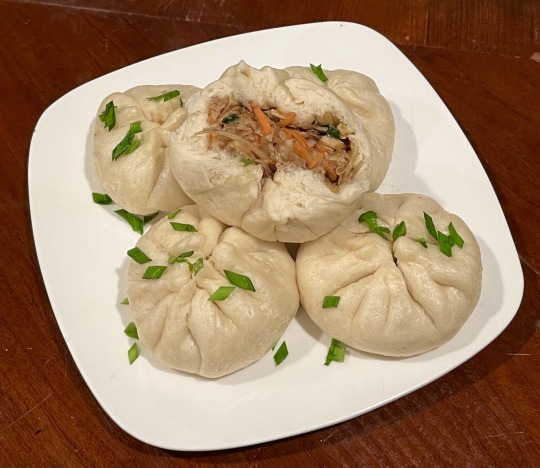
[ID: Five large, enclosed bao piled on a plate. The topmost bao has been opened to show a bread-like dough texture and a vegetable filling. The bao are garnished with chopped chives. End ID]
Bánh bao chay (Vietnamese vegetable dumplings)
Bánh bao are an iteration on the Chinese da bao (大包) brought to Vietnam by Cantonese immigrants. Like da bao, bánh bao are commonly filled with some combination of minced meat, Chinese sausage, and hard-boiled eggs; however, some versions of bánh bao are also made with Vietnamese vegetables, herbs, and flavorings. Vegetarian bánh bao (bánh bao chay) may have no filling, a filling consisting of a variety of vegetables, or a filling of sweetened beans or sweet potato.
This recipe combines Vietnamese vegetables, herbs, spices, and sauces with Vietnamese meat substitutes to make a well-rounded filling that's equal parts umami and fresh. The yeasted, enriched dough is tasty, fluffy, and light, but still has enough structure to hold up against the filling.
Recipe under the cut!
Patreon | Tip jar
Makes 16-20; serves 6.
Ingredients:
For the dough:
4 cups + 2 Tbsp (500g) all-purpose flour
2 tsp (7g) active dry yeast
7 Tbsp (90g) granulated sugar
1/2 tsp salt
2 tsp (10g) baking powder (optional)
2 Tbsp (16g) cornstarch (optional)
1 - 1 1/4 cup (135-295 mL) lukewarm soy or oat milk, or water
1 Tbsp cooking oil
The basic components of this dough are flour, yeast, sugar, salt, oil, and milk. The baking powder is added to help with leavening; the cornstarch works to create a light, fluffy dough that will not become soggy when filling is added.
For the filling:
1 large carrot (100g)
4-inch piece (120g) cassava root / yuca
1 cup (100g) shiitake or wood-ear mushrooms, diced
4 large pieces (50g) sườn non chay, or 1/2 cup diced or crumbled chả lụa chay
1/2 cup water + 1/2 tsp vegetarian 'chicken' broth concentrate (optional)
50g tofu skin (đậu hủ ky)
1 red onion, minced
5 cloves garlic, chopped
4-5 chives or scallions, finely chopped
1 tsp freshly ground black pepper
1/2 tsp sugar, or to taste
1/2 tsp salt, or to taste
2 tsp bột nêm chay, ground to a powder (optional)
1 1/2 tsp fermented bean paste + 1/2 tsp light soy sauce (or 2 tsp vegetarian fish sauce)
2 tsp vegetarian oyster sauce
1/4 cup soybean oil, peanut oil, or other cooking oil, divided
Sườn non chay (roughly, “vegetarian ribs”) is a meat replacement made of textured soy protein. It may be found in bags online or in the pantry / dried goods section at your local Asian grocery store—the bags will be labelled “sườn non chay” as well as “vegan meat slice,” “textured soy bean protein,” “vegetarian food,” or “vegan food.” Most sườn non chay are large and pale in color, but they sometimes come in "beef" or "pork" styles—the difference is not the flavoring but rather the size, shape, and coloring of the pieces. In my experience, the "beef" ones are more darkly colored, and both "beef" and "pork" styles are smaller in size and thinner in shape than the non-specific ones, which I often use to replace chicken.
Chả lụa chay is a vegetarian version of a Vietnamese pork sausage. It can be found in the form of a large loaf in the refrigerator section of a Vietnamese or Asian grocery store. It will be labelled "chả lụa chay" or "gio lụa chay," as well as "vegetarian pork roll," "wheat meat," or "vegetarian food."
Đậu hủ ky, or tofu skin, is prepared by taking the film off of a batch of tofu as it sets. Tofu skin may be purchased fresh or dried, in sheets or in sticks: for the purposes of this recipe, any kind will work! Chinese tofu skin produced for sale abroad may be labelled "dried beancurd sticks."
Bột nêm is a Vietnamese seasoning sold in powder or granule form. Vegetarian ("chay") versions of the seasoning may contain shiitake mushroom, lotus seeds, carrots, tomatoes, and kohlrabi, as well as salt and MSG. It can be purchased in pouches or boxes from an Asian grocery store, or you can use any other vegetable stock powder.
Fish sauce and oyster sauce are common inclusions in pork fillings for bánh bao but are often simply omitted from vegetarian ones. I've used vegetarian substitutes for these ingredients—if you don't have vegetarian imitation fish or oyster sauce, just increase the amount of salt, sugar, and bột nêm to taste.
Instructions:
For the dough:
1. Heat 1 cup (135mL) non-dairy milk to lukewarm in a saucepan or in the microwave. Stir in the yeast to dissolve. if you’re not sure your yeast is alive, proof it by allowing to stand for 10 minutes—it should foam.
2. Add the baking powder, sugar, and salt and whisk to dissolve.
3. In a large bowl, whisk together flour and cornstarch. Pour in the milk mixture and mix well to combine. Add additional milk 1 tsp at a time if it remains too dry to combine. The dough should be slightly tacky but not sticky.
3. Add oil and knead by hand until dough is smooth and elastic, about 10 minutes. Cover with plastic wrap and allow to rise in a warm place for about 3 hours until doubled in size. If you live in a cold climate and don't have a proofing drawer, heat your oven on the lowest setting for a few minutes, turn it off, and then proof the dough in the oven.
For the filling:
1. Prepare the proteins. Soak the tofu skin (if you're using dried) and sườn non chay in cool water for about half an hour until rehydrated (or simmer them for a shorter amount of time). They are fully hydrated once flexible and a couple shades lighter. Gently squeeze the water out. Dice tofu skin; rip sườn non chay into small pieces lengthwise and then dice widthwise.
2. Prepare the vegetables. Peel cassava root and carrot. Cut both into a fine julienne, or grate them. Dice the mushrooms; mince the red onion; chop the garlic.

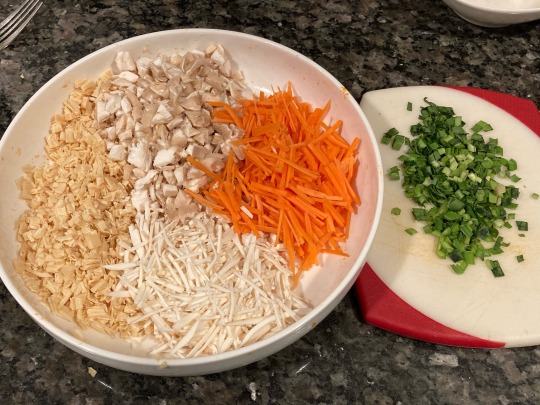
3. Cook the filling. Heat oil in a large skillet on medium. Add the garlic and sauté until fragrant.
4. Add the red onion and continue to sauté until fragrant and slightly softened. Add black pepper, bột nêm, and salt and allow to cook another 30 seconds.
5. Add carrot, cassava, mushrooms, chả lụa chay (if using), and tofu skin and stir to combine. Reduce heat to low and cook, stirring often, until tender. Remove from pan.
6. If using sườn non chay: in the same pan, fry sườn non chay in 3 Tbsp of cooking oil on medium until they’ve absorbed the oil. Whisk 'chicken' stock concentrate into a small amount of hot water, then add the stock into the pan. Cook until mostly dry.
Soaking in water, deep frying in oil, then simmering in a flavored broth is the typical Vietnamese preparation of sườn non chay. The simmering in stock could potentially be skipped if you're including vegetarian oyster and/or fish sauce, but personally I find that dried soy products benefit from being soaked or simmered in something other than water.
7. Mix sườn non chay in with other filling ingredients, salt, sugar, sauces, and chives.
To assemble:
1. Turn dough out from its proofing bowl and gently divide into two even parts. Cover the half you're not using and gently roll the other out into a log of even width. Use a dough cutter or sharp knife to divide the log into 8 or 10 even pieces.
2. Place each disc of dough on its side and roll it out into a circle about 5" (13cm) in diameter. The edges of the circle should be much thinner than the center, since the edges will be bundled up and folded together.
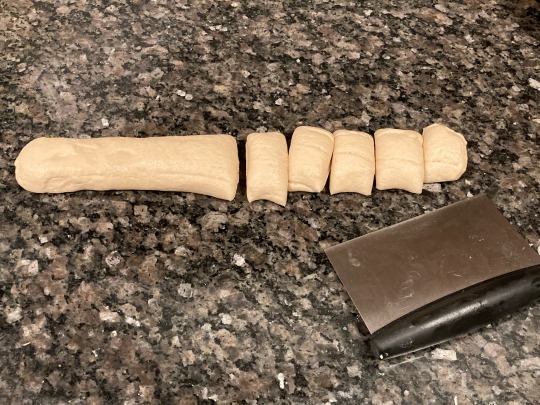
3. The folding method is the same as for baozi and momos. Hold a wrapper in the palm of your non-dominant hand and add a couple tablespoons of filling (if you’re not experienced with making dumplings, it may be easier to add less). While pressing the filling down with your non-dominant thumb, use your other hand to pinch pleated folds in the dough all the way around the circle of the wrapper. Remove your thumb and make one last fold to close the bao. Pinch firmly at the place where all the pleats come together (where the drawstring would be if it were a drawstring pouch) and give a small twist to seal.
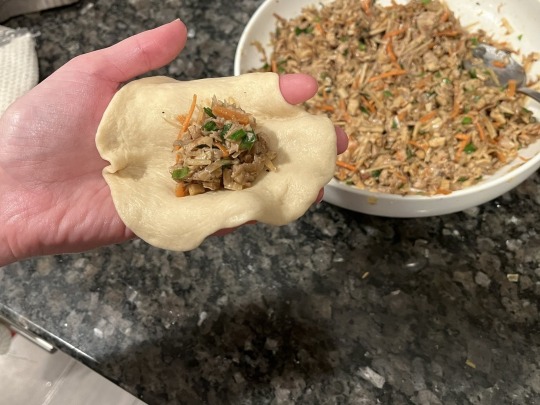
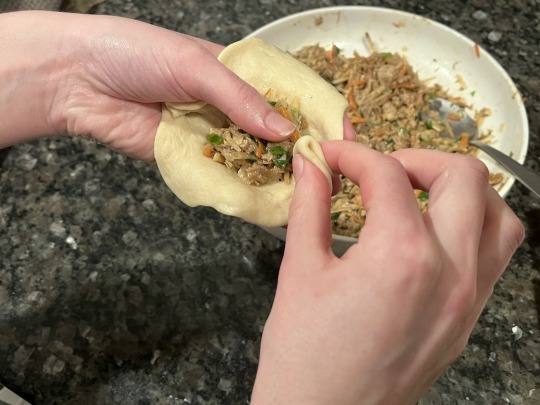
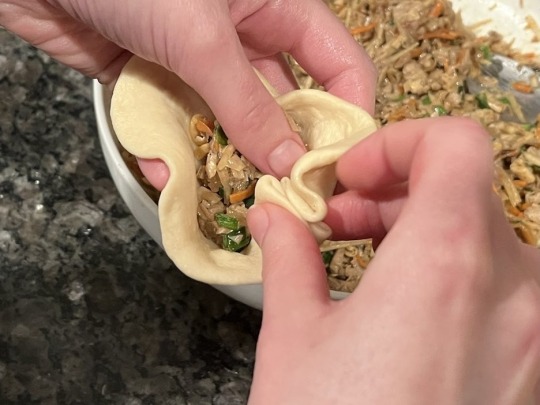


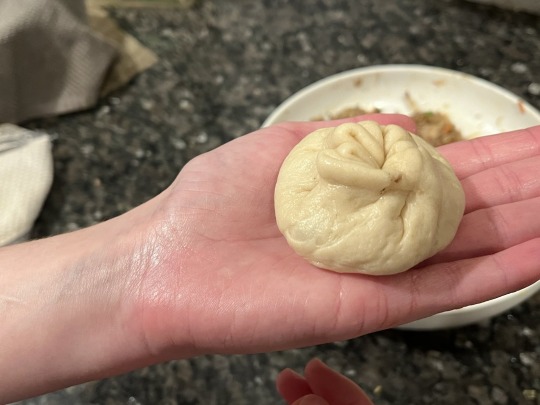
4. Set each finished bao on a small square of parchment paper on a baking sheet or in a steamer and lightly cover with plastic wrap or a light kitchen towel. Continue folding until you have formed all of the bao.
To steam:
1. Place a bamboo steamer in the bottom of a wok or large pot, and fill the wok with enough cool water to cover the bottom rim of the steamer by ½". If you've added baking powder to your dough, you may add a splash of vinegar to the water to help neutralise the dough's pH and combat yellowing of the dough.
If you’re using a metal steamer, tie a kitchen towel around its lid to prevent condensation from dipping back down onto the dumplings. Carefully place the bao, along with their parchment paper squares, into the steamer, leaving an inch or so between each one. They will expand as they steam!
If you don’t have a steamer, place a small bowl in the bottom of a wok or large, deep pan or pot. Place the dumplings, with their parchment paper squares, on a plate and place the plate on top of the bowl–the plate should fit inside your pot. Make sure that you can cover the plate and dumplings with a lid. If your lid is domed, there is no need for a kitchen towel, since the condensation will run down towards the outer rim. If your lid is flat, tie a tea towel around it just as you would with a metal steamer. Fill your cooking vessel with 2 or so centimeters of cool water.
2. Raise the heat to high and allow the water to come to a boil. Once boiling, lower the heat to medium-low and cover your steamer or pot. Steam the dumplings for about 8 minutes, until the dough is tender and cooked through. Keep finished bao warm in a covered casserole dish in an oven on low while you steam the others.
#vegetarian recipes#recipes#vegan recipes#Vietnamese#dumplings#carrots#cassava root#tofu skin#mushrooms#sườn non chay#chả lụa chay#fish sauce#chives
281 notes
·
View notes